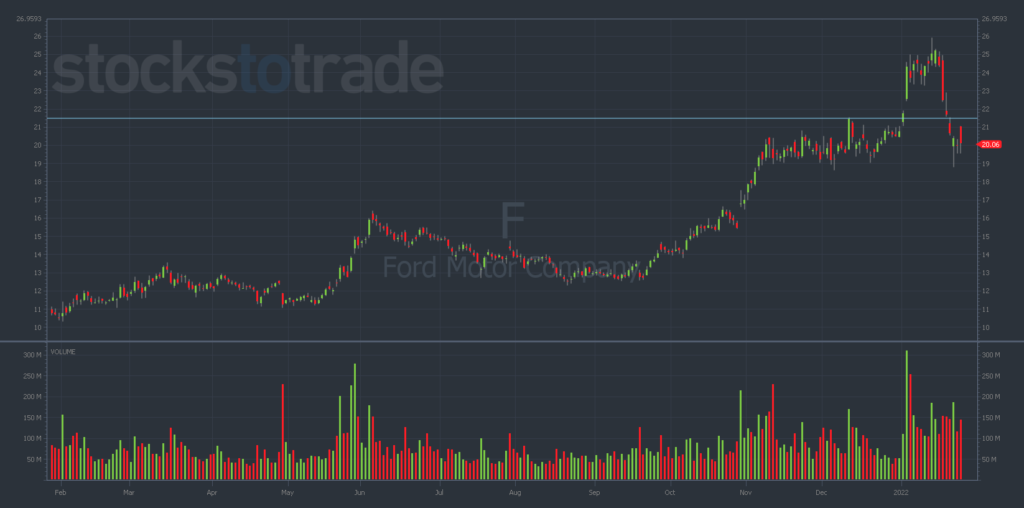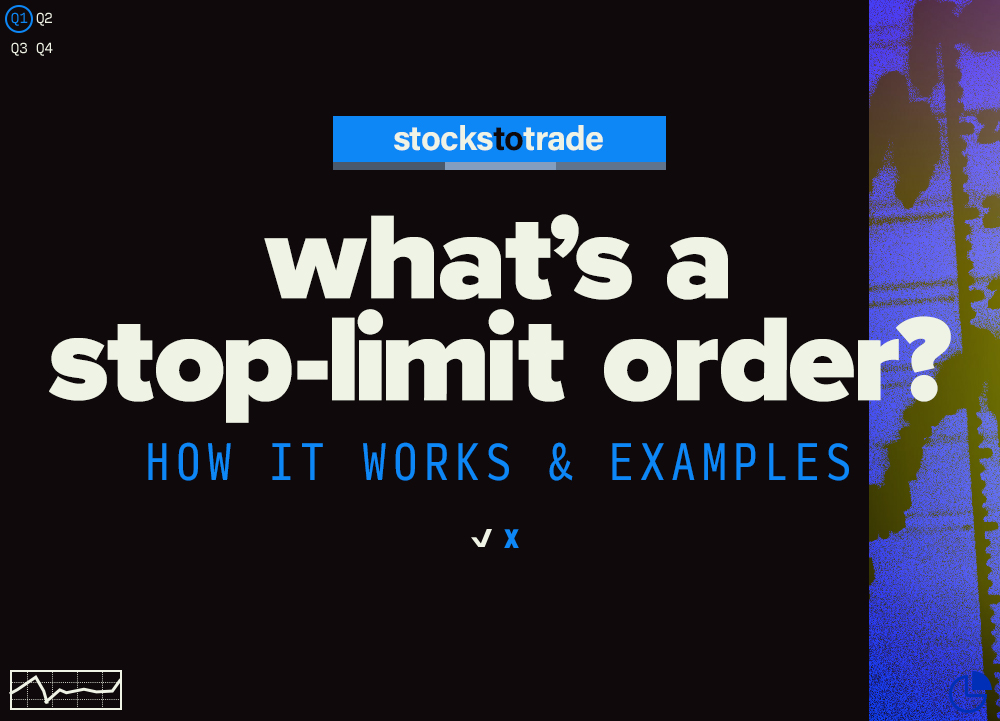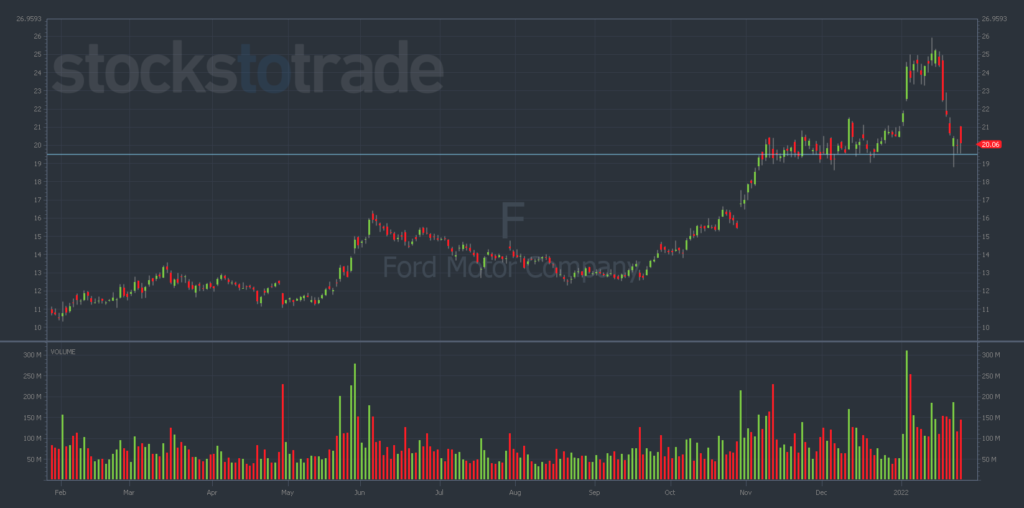Stop-Limit Order: Key Takeaways
- Bummed about missing your intended price point? Find out how to avoid that here!
- What’s a stop-limit order? Read on for everything you need to know…
- Need examples? See how you can use this order type to your advantage…
Too many day traders lose money because they don’t understand all the different order types available to them.
When you use a market order, you risk getting terrible prices. It can mean missing trades or LOSSES. Nobody wants that…
That’s why it’s helpful to understand order types and how to best use them.
Today I’ll take a close look at one in particular — the stop-limit order.
What exactly is this order type and how can it help you in your everyday trading?
I’ll cover it all below. Let’s jump in!
Table of Contents
What Is a Stop-Limit Order?

© StocksToTrade
The stop-limit order combines parts of two order types: the stop order and the limit order.
With a stop order, you tell your broker, “when the price hits $x, buy (or sell) the stock.”
For example, you might want to hold XYZ stock if it breaks out above $10. You can set a stop order … And if the price trades at $10 or higher, your broker will try to buy your shares, no matter the price.
On the other hand, with a limit order, you tell your broker, “Buy this stock at any price up to $x.”
So say XYZ is trading at $8 and you set a limit order to buy 1,000 shares at a limit of $8.20. Your broker will buy up to 1,000 shares at any price under $8.20.
Now let’s look at the stop-limit order, which combines the stop and limit orders.
The stop-limit order triggers a limit order when a stock price hits the stop level.
So you might place a stop-limit order to buy 1,000 shares of XYZ, up to $9.50, when the price hits $9.
In this example, $9 is the stop level, which triggers a limit order of $9.50. Combining the two, we have the stop-limit order.
This type of order can be super helpful for day traders and swing traders who can’t watch the markets all day. And they can be especially useful for stocks with thin trading volume, such as penny stocks.
Let’s look more closely at how these orders work, along with when and how to use them.
Why Combine Both a Stop Order and Limit Order?
So what’s the point of using a stop-limit order? Why not just use a stop-loss order?
Let’s look at an example to better understand stop-limit orders…
Say you set a basic stop-loss order to sell 100 XYZ shares if the price declines to $10. The order means you’ll sell 100 shares at the market — no matter what the price is.
The trading volume on this stock is thin … There aren’t many current bids for the stock. That means you can receive a terrible fill and end up selling your position for much less than $10.
The result is a larger loss than you anticipated…
Imagine that same situation, only this time you use a stop-limit order. You still want to sell 100 XYZ shares if the price drops to $10. But you enter a stop-limit order with a limit of $9.80.
Now, if the price declines to $10, your broker will sell as many of the 100 shares as possible, down to a price of $9.80. You may be able to sell all of them or only a handful — but you won’t sell any below the $9.80 level.
There are a few key concepts to consider when using this order type. There are also some risks to consider…
How Stop-Limit Orders Work
Once you enter this order through your trading platform, it’s then placed on the order book at the exchange. The order remains there until it’s triggered, it expires, or you cancel it.
When you place the order, you decide how long it will be valid. You can select a good-till-canceled (GTC) order. That means it stays in the order book until it’s triggered or you cancel it…
Alternatively, you may only want the order filled in that day’s trading session. In that case, you’d use a day order to tell the exchange to cancel the order if it isn’t filled by the end of the day.
Stop-limit orders are only valid for standard market hours between 9:30 a.m. and 4 p.m. Eastern time. These orders aren’t filled in after-hours or premarket sessions. These are generally times of extremely low trading volume.
Why Do Traders Use Stop-Limit Orders?

© StocksToTrade
Let’s look at the kinds of situations in which you could use a stop-limit order. It’s important to note that you can use it in a variety of ways…
#1. To buy a stock: You can use the order to purchase a stock if the price hits a certain level.
#2. To short sell a stock: You can use the order to short sell a stock if the price drops to a certain level.
#3. To stop loss out of a long position. You can use the order to exit your long position if the price declines.
#4. To stop loss out of a short position. You can use the order to exit your short position if the price rises.
With any of these four situations, you can use a simple stop-buy or stop-sell order. But if the trading volume’s thin, you can end up paying way too much or selling for way too little.
That’s why traders might use a stop-limit order. They can select the limit price at which they’re willing to buy or sell.
Stop-limit orders can be especially useful for part-time traders who can’t watch trades throughout the trading day. And this order type allows for specific criteria.
That can help busy traders receive a better fill without having to actively watch the order book.
Trailing Stop-Limit Order
When you buy a stock, and the price starts to move in your favor, it can be helpful to have a trailing stop-loss order in place. This order will constantly move your stop-loss up as the price rises.
For example, you may want a trailing stop order at 10% below the stock’s highest recent trading price. As the price moves up, your stop-loss order will follow the price up. It stays within 10% of the highest price.
Using a trailing stop can potentially help you profit from the stock’s upward move. And you may be able to lock in profits if the price starts to decline.
The trailing stop-limit order works the same as the trailing stop-loss, but with a limit order attached to it. So if the price drops to a certain level and you want to exit, your broker knows to sell the stock — but only down to the specified limit price.
Trailing stop-limit orders can be especially useful in low float penny stock runners. These stocks can make big moves and this order can help you protect gains.
Stop-Limit Order Examples
Let’s look at some real-world examples where a stop-limit order could be a part of a well-planned trading strategy.
Stop-Limit Buy Order Example

Ford Motor Company (NYSE: F) with a Stop-Limit Buy Order Level (Source: StocksToTrade)
Looking at Ford’s chart, we can see that the stock’s in a long-term uptrend but recently had a pullback.
Maybe you believe this stock will dominate the electric vehicle space and that it’ll head higher soon. You want to jump in on the way up. A stop-limit order can help you with that.
You set a stop-limit order to buy 100 shares of F at $21.50 (the blue line on the chart). You also set a limit of $21.60 and select GTC.
This means that you won’t have to watch the market action. If F trades at $21.50 or above, your broker will buy you 100 shares up to a price of $21.60.
Stop-Limit Sell Order Example
Let’s contrast to our previous example and assume you’re bearish on F. You think its EVs will flop and the stock price will tank as a result…
So you decide to short sell the stock. And before you take a short position, you want to see price trade below the stock’s recent swing low of $19.50.
You enter a stop-limit sell order to sell 100 shares of F at a stop of $19.50 with a limit of $19.25, selecting GTC in the order details.
This means you can move on to other trades (or life) without having to babysit what happens with F. If it trades below $19.50, you’ll enter into a short position at a price you’re happy with.
When to Use Stop-Limit Orders
Using specific order types in certain situations all depends on your trading strategy. It’s up to you to build a trading strategy and determine the right order types to use.
That said, here are a few things to consider when using stop-limit orders…
When You’re Trading Illiquid Stocks
If you try to sell a position using a market order on a thinly traded stock, you can get filled 10%, 20%, or more away from the current market price.
That’s because there’s not enough trading volume.
Having a limit on your order in an illiquid stock means your order may be gradually filled as buyers pop up throughout the session to purchase the stock.
When You’re Trading Part-Time
It’s just not possible for all traders to watch the market or order books all day…
The next best thing is to use orders like stop-limits. They provide some additional peace of mind compared to a basic stop order.
Be warned though — there are risks involved. Let’s check those out next…
Stop-Limit Order Risks

© StocksToTrade
Stop-limit orders can have some potential advantages. But this order type also has some downsides and risks…
Here are a few things to consider when choosing whether to use a stop-limit order.
#1 Stop-Limit Order Risk: You May Not Get Filled
There will be situations where your stop gets triggered, but liquidity is so thin that the market trades straight through your limit price.
Guess what? Your order isn’t filled.
It works like this … Imagine you own 1,000 shares of XYZ. You set a stop-limit order to sell if the price trades at $10, with a limit of $9.80.
Now, when the stock trades below $10 and triggers your stop, there are no buyers and the price quickly plummets to $9.60.
In this case, the stock now trades below your limit price, but you’re still holding the losing position.
#2 Stop-Limit Order Risk: You May Only Get a Partial Fill
Similar to the above example, your stop may get triggered and you’re looking to sell out of your 1,000 shares. But due to a lack of liquidity, you only sell a fraction of your position.
For instance, the price drops below $10. It’s a low-volume stock and you’re only able to sell 100 shares. But the price quickly plummets to $9.60.
You’re still holding 900 shares that are below your stop-loss level. This can turn a small loss into a large one.
#3 Stop-Limit Order Risk: You May Pay a Larger Commission
Depending on your broker’s commission fees, you may pay more commissions if your order gets filled in multiple parts.
So you may pay a minimum order fee to your broker for each trade. Your stop-limit order may get filled in three separate trades over multiple days due to the lack of liquidity. You can end up paying the minimum order fee three times.
If you had sold your position at market, you’d pay only once.
These are some of the risks you need to weigh when determining whether to use a stop-limit order. Make sure to build a detailed trading plan, including order types, before entering any trades.
3 Handy Stop-Limit Order Strategies
Let’s see a few handy strategies with this order type…
#1 Stop-Limit Order Strategy: Use Charts to Determine Key Levels
It’s smart to set stop-limit orders where you expect other traders to buy and sell. These levels are often major support and resistance levels or previous key swing highs and lows.
Analyzing stock charts is a great way to determine these key levels. You can use the horizontal line tool on your charting platform to look for areas where the market historically turns around.
Once you locate these key levels, it’s often smart to place your orders around them. You can often expect liquidity to pick up as the price approaches them.
#2 Stop-Limit Order Strategy: Consider the Stock Volatility When Setting Your Limit
Selecting the right limit amount for a stop-limit order is both an art and a science.
If you set your limit too tight, you’re less likely to get a fill. If you set your limit too loose, you might pay a bad price. That can hurt you with bigger losses or smaller gains.
It’s important to consider the stock’s volatility. The more volatile, the wider limit you want to have.
#3 Stop-Limit Order Strategy: Keep an Eye on Trading Volume
It’s important to analyze a stock’s trading volume when determining whether to use a stop-limit order. It’s also smart for deciding where to place your limit.
If a stock has a huge amount of liquidity historically, you may be better off using a stop-order without a limit. You can reasonably expect that liquidity will be there.
If the stock’s too illiquid, it may be smart to lower your position size to better manage your risk.
Ready to Trade? Come Check Out StocksToTrade

© StocksToTrade
Selecting the right order type is just one piece of the puzzle when it comes to trading smart.
You also want to scan the market for the best opportunities. You need to know how to analyze the hottest stocks. And you gotta keep up with the news, manage your risk/reward, and so much more…
It’s a huge process, and it can be daunting. But the right tools that can help you manage it all every day — like the StocksToTrade platform.
StocksToTrade is a best-in-breed stock trading and analysis platform created by traders,= for traders. Inside the platform, you have access to charts, quotes, newsfeeds, scanning, watchlists, and so many other tools to help make your trading day more streamlined.
Fun fact: Many of the world’s best traders use our platform every single day. Find out why now … Get a 14-day trial of the platform for just $7! See what a premium trading toolbox looks like.
Conclusion
Stop-limit orders can be useful for active traders, especially those who trade penny stocks.
A lot of newbies skip learning about order types. But the reality is that they can be a part of a smart trading strategy.
It’s helpful to understand them. It can give you more insight into how other traders are navigating the markets…
This order type is great to know, especially as it relates to volatility and trading volume.
When you’re ready, you might want to try using an order on a trade or two. If so, start small and see how it goes.
And if you want some additional guidance on your trading, check out the SteadyTrade Team!
What’s the most common order type you use and why do you use it? Tell me below!

